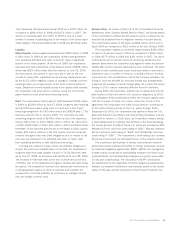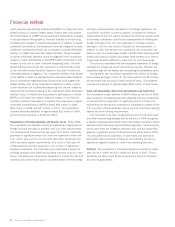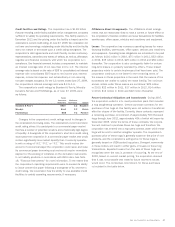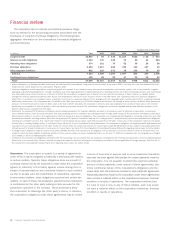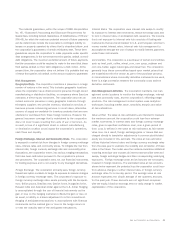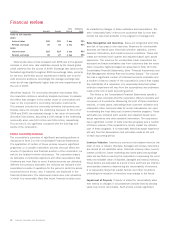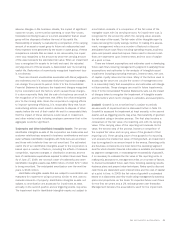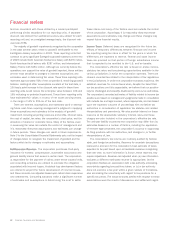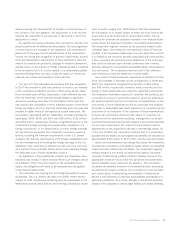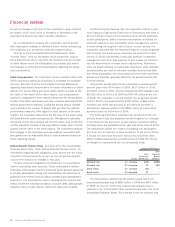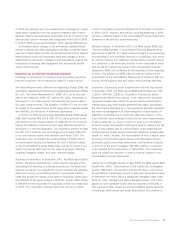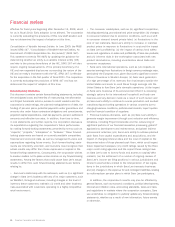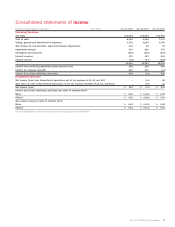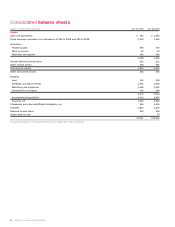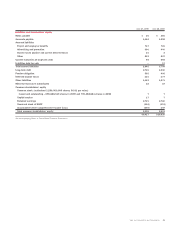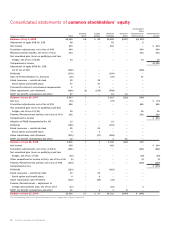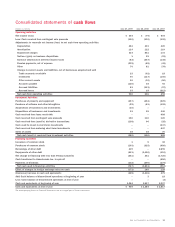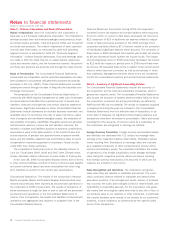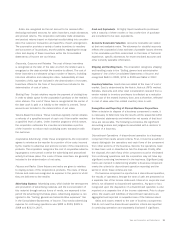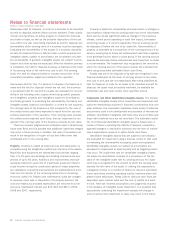Sara Lee 2009 Annual Report Download - page 46
Download and view the complete annual report
Please find page 46 of the 2009 Sara Lee annual report below. You can navigate through the pages in the report by either clicking on the pages listed below, or by using the keyword search tool below to find specific information within the annual report.
Financial review
as well as changes in the level of the corporation’s gross deferred
tax assets, which could result in increases or decreases in the
corporation’s deferred tax asset valuation allowance.
As a multinational company, the corporation cannot predict
with reasonable certainty or likelihood future results considering
the complexity and sensitivity of the assumptions above.
Note 21 to the Consolidated Financial Statements, titled
“Income Taxes,” sets out the factors which caused the corpora-
tion’s effective tax rate to vary from the statutory rate and certain
of these factors result from finalization of tax audits and review
and changes in estimates and assumptions regarding tax obliga-
tions and benefits.
Stock Compensation The corporation issues restricted stock units
(RSUs) and stock options to employees in exchange for employee
services. See Note 8 to the Consolidated Financial Statements
regarding stock-based compensation for further information on these
awards. The cost of RSUs and stock option awards is equal to the
fair value of the award at the date of grant, and compensation
expense is recognized for those awards earned over the service period.
Certain of the RSUs vest based upon the employee achieving certain
defined performance measures. During the service period, manage-
ment estimates the number of awards that will meet the defined
performance measures. With regard to stock options, at the date
of grant, the corporation determines the fair value of the award using
the Black-Scholes option pricing formula. Management estimates
the period of time the employee will hold the option prior to exercise
and the expected volatility of the corporation’s stock, each of which
impacts the fair value of the stock options. The corporation believes
that changes in the estimates and assumptions associated with
prior grants are not reasonably likely to have a material impact on
future operating results.
Defined Benefit Pension Plans See Note 19 to the Consolidated
Financial Statements, titled “Defined Benefit Pension Plans,” for
information regarding plan obligations, plan assets and the meas-
urements of these amounts, as well as the net periodic benefit
cost and the reasons for changes in this cost.
Pension costs and obligations are dependent on assumptions
used in calculating such amounts. These assumptions include
estimates of the present value of projected future pension payments
to all plan participants, taking into consideration the likelihood of
potential future events such as salary increases and demographic
experience. The assumptions used in developing the required esti-
mates include the following key factors: discount rates, salary growth,
expected return on plan assets, retirement rates and mortality.
In determining the discount rate, the corporation utilizes a yield
curve based on high-quality fixed-income investments that have a
AA bond rating to discount the expected future benefit payments
to plan participants. Salary increase assumptions are based on
historical experience and anticipated future management actions.
In determining the long-term rate of return on plan assets, the
corporation assumes that the historical long-term compound growth
rate of equity and fixed-income securities will predict the future
returns of similar investments in the plan portfolio. Investment
management and other fees paid out of plan assets are factored
into the determination of asset return assumptions. Retirement
rates are based primarily on actual plan experience, while standard
actuarial tables are used to estimate mortality. Results that differ
from these assumptions are accumulated and amortized over future
periods and, therefore, generally affect the net periodic benefit cost
in future periods.
Net periodic benefit costs for the corporation’s defined benefit
pension plans were $74 million in 2009, $107 million in 2008
and $141 million in 2007, and the projected benefit obligation was
$4,218 million at the end of 2009 and $4,744 million at the end
of 2008. The corporation currently expects its net periodic benefit
cost for 2010 to be approximately $140 million, a $66 million
increase over 2009 due primarily to an expected increase in
amortization expense related to the $883 million of unamortized
actuarial losses as of the end of 2009.
The following information illustrates the sensitivity of the net
periodic benefit cost and projected benefit obligation to a change
in the discount rate and return on plan assets. Amounts relating
to foreign plans are translated at the spot rate at the close of 2009.
The sensitivities reflect the impact of changing one assumption
at a time and are specific to base conditions at the end of 2009.
It should be noted that economic factors and conditions often
affect multiple assumptions simultaneously and that the effects
of changes in assumptions are not necessarily linear.
Increase/(Decrease) in
2009
2010 Projected
Net Periodic Benefit
Assumption Change Benefit Cost Obligation
Discount rate 1% increase $(43) $(485)
Discount rate 1% decrease 49 550
Asset return 1% increase (37) –
Asset return 1% decrease 37 –
The corporation’s defined benefit pension plans had a net
unamortized actuarial loss of $883 million in 2009 and $570 million
in 2008. At June 27, 2009, this unamortized actuarial loss is
reported in the “Accumulated other comprehensive loss” line of the
Consolidated Balance Sheet. The increase in the net actuarial loss
44 Sara Lee Corporation and Subsidiaries



